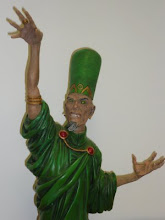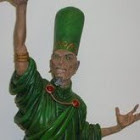 Gripping and entraining, the issue has a very clever balance between conflict and aftermath in the city and the settlement as the plot mechanics start to take up the weight of the story. At the settlement the assault lead by the giant werewolf on the Settlement starts. The inhabitants fight back while the soldiers returning from a patrol attack the wolves from the rear. In the city Halfpenny finds himself surrounded by an angry crown as he leaves the house where Fabian was assassinated. The confrontation is exactly to Halfpenny's liking, it becomes deadly very quickly. The aftermath of the two confrontations are not conclusive, they push open doors to further complications and trouble for everyone.
Gripping and entraining, the issue has a very clever balance between conflict and aftermath in the city and the settlement as the plot mechanics start to take up the weight of the story. At the settlement the assault lead by the giant werewolf on the Settlement starts. The inhabitants fight back while the soldiers returning from a patrol attack the wolves from the rear. In the city Halfpenny finds himself surrounded by an angry crown as he leaves the house where Fabian was assassinated. The confrontation is exactly to Halfpenny's liking, it becomes deadly very quickly. The aftermath of the two confrontations are not conclusive, they push open doors to further complications and trouble for everyone.This issue marks the point where the set up has been completed and the story has to develop by itself and it is doing so with the usual care and attention from Jim Alexander. The question of why the vampires do not simply drink the werewolves blood is definitively answered and the precarious situation of the Settlement, which has many more enemies than just werewolves is made plain. Suitably in the more complex area of the city Halfpenny enjoys his triumph while still not quite grasping the danger from his apparent allies. Jim Alexander nicely matches the action with the context, more straightforward and direct in the Settlement, dangerously ambiguous in the city.
Will Pickering moves from widescreen action to multiple panel pages to single panel pages with strong control of the pacing and story requirements. Crowd scenes get the space they need to set the context, the action is much more focussed and personal.Conflict is hand to hand and it gets the attention it needs to display the personal aspect to every encounter. The werewolves and the vampires are not simply battling each other, they have to obliterate each other. In the city the clash of faith and politics is no less personal, it just is expressed in slightly different terms. The art captures the forces behind the action and gives the conflict a sharper edge.
Wolf Country continues to be a wonderful comic, a tremendous idea being executed with flair and thoughtful skill leading in unexpected directions and developing a deeply engaging and independent cast. It is a pleasure to see the huge promise made in the first issue being realised in such a positive and confident way.
Chief Wizard Note: This is a review copy very kindly sent by Jim Alexander. The book is available for pre-order on the new Planet Jim shop hop on-line: https://www.etsy.com/uk/shop/







